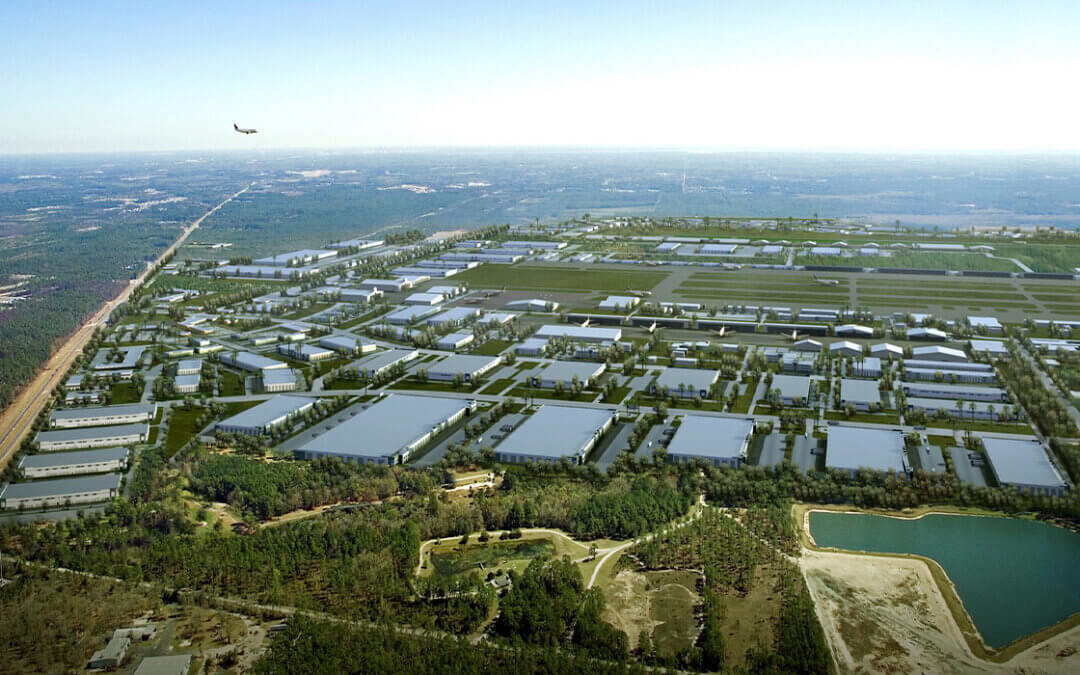JAA pivots on Cecil, looking to build on R&D activity at site (Courtesy of the Jacksonville Business Journal) –For more than a decade, spaceflight launches at Cecil Air and Spaceport has been a goal of the Jacksonville Aviation Authority, with plans of capitalizing on the facility’s 12,503-foot-long runway and room for industrial buildings.
But those plans never came to fruition — and the airport has now pivoted, with the authority’s focus now on finding ways to develop aerospace research and development facilities on Cecil east side.
And companies are taking interest. In June, the Jacksonville Aviation Authority confirmed that Hermeus, a hypersonic aircraft company, is exploring an expansion to Jacksonville.
With land that can fit New York’s Central Park and Washington’s National Mall, Cecil Airport’s eastern side is close to a blank canvas for development. And work is already underway to unlock its potential.
As Boeing’s facility for maintenance repair and overhaul for the U.S. Navy’s P-8 multi-mission, maritime patrol aircraft opened earlier this year, JAA continues to court companies with the abundance of space they have.
Building on Boeing
The seed for development is starting off with the extension of Approach Road, which serves as an entryway from 103rd Street to Boeing’s 385,000-square-foot maintenance, repair and overhaul facility for the U.S. Navy’s P-8 multi-mission, maritime patrol aircraft.
“This facility really represents, I think, expanded capacity and allows us to do the P-8 work that we’re doing for the Navy,” Rhiannon Sherrard, the Boeing site leader for Jacksonville, said. “Our previous facility … really didn’t have the space to accommodate a jet the size of a P-8, so this gives us the opportunity to offer up more services to the Navy.”
Next to the P-8 plane MRO facility, a 150,000-square-foot component operations repair facility is planned for work on flight control surfaces and parts for F/A-18 and KC-46 aircraft, and is set to be in operation later this summer, according to Boeing.
The Boeing South Yard facility, a 201,714 square foot MRO hangar for KC-46A aircraft, is expected to be complete by 2026, Sherrard said.
Work is being done to extend the road beyond Boeing’s facilities into land that has long remained untouched. The road extension is a $20 million project, with funding coming from JAA and grants from the Florida Department of Economic Opportunity, Florida Department of Transportation and Space Florida.
Upon completion, the extended road will be an access point for potential buildings tied to aerospace activities, connecting workers and students coming in and out of the facility to and from 103rd Street.
Education opportunities
Cecil Airport already has opportunities in place for use of its current spaceport facilities for educational uses. Cecil has allowed Embry-Riddle Aeronautical University to test rocket engines fixed on the ground.
Finding space near the university’s Daytona Beach campus was a struggle, said Eric Perrell, a professor of aerospace engineering at Embry-Riddle.
“I’ve been at Embry-Riddle now for 21 years, and for much of that time, I and we, and all the students that I’ve been working with and some of the faculty as well, have been looking for a place in proximity to campus where we could do this sort of thing, and there just isn’t any,” Perrell said. “The population density is too high, and we’re right next to the (Daytona Beach) airport, so the airport doesn’t want us lighting things up that close to the runways … things that might go awry or things that might scare the people flying over.”
The Embry-Riddle students conducting tests at Cecil have the perfect space for gaining more hands-on experience.
“It’s a little over an hour drive to Cecil field, and they just have the infrastructure,” Perrell said. “They have the wide open spaces where we can test things that might go high order, so to speak, and that has happened. It’s happened a number of times.”
The projects could lead to unprecedented growth for the westside airport and spark more development of food and retail along 103rd Street, said Matt Bocchino, the director of Cecil Airport and Spaceport.
Bocchino said that he’s focused on unlocking the potential of the eastern side of the airport, with a focus on catering to aerospace research and development.
“The ancillary operations, so laboratory space, university space, we’re talking to different colleges to see because a lot of the colleges in Florida have aerospace programs, and, of course, aeromedical programs,” Bocchino said. “So we see this as a perfect spot for that sort of development.”
JAA is not constructing any of these facilities at this moment but would look at working with other parties to do that.
There is no firm timeframe for the development, said Greg Willis, a JAA spokesperson.
Turning away from space
In 2020, horizontal launch was just around the corner, the then-director of the spaceport. Nearly four years later, none have happened.
While the site has the capacity, Bocchino said the reality of that is far in the future.
“Launch would be the sexy thing. Without a doubt, that would be the headline grabber,” Bocchino said. “And the interesting thing is, if you were to do launch here, you actually wouldn’t see much here at the airport. It would basically be an aircraft taking off with a rocket attached to it. The launch would happen out over the ocean, which I hate to downplay potential coolness out here, but the cool stuff would happen out of sight of land.”
But as of 2024, horizontal launch is only happening in a small pocket of the United States.
“It’s basically just the reality of the horizontal launch market, that there is only one viable launch operator, and they’re based in New Mexico,” Bocchino said. “Outside of that … there really isn’t that sort of thing going on. That’s not to say it couldn’t happen here.”
JAA CEO Mark VanLoh said that the abundance of land is what’s key for aerospace development at Cecil.
“The spaceport decision was before my time, and that was the buzzword at that time. And everybody wanted to be a spaceport,” VanLoh said. “And so you had a massive influx of airports wanting to be on that list. And I think they were, we were all ahead of our time.
“Everyone thought that would be the mode to get into space: horizontal launch. It’s a lot less expensive, it’s a lot easier, technically. But we’re seeing all the activity at (Cape Canaveral) that vertical seems to be the way to go. It’s the big payloads and they can take just about anything into space now. But that being said, we still think Cecil has a valuable role to play because we have room. We have room for companies to set up research and development.”
Looking to the future
As the land is seen as prime real estate for other aerospace activity, it could be a future incentive for companies to consider Cecil for launch and reentry. The Cecil director summed it up as “if you build it, they will come.”
That includes companies like Hermeus, which would create 100 full-time jobs, with an average annual wage of more than $100,000.
The Atlanta-based hypersonic aircraft company, is exploring Cecil Airport as a location for a test facility for hypersonic engines for the Department of Defense.
The company intends to make a $135 million capital investment, with $37 million in tangible personal property, to test, develop and manufacture the hypersonic engine. The project would create 100 full-time jobs, with an average annual wage of more than $100,000.
More projects like that might be on the way, spurred by state support of space research and the open space provided by the site.
“There are benefits to developing here,” Bocchino said. “You have access to FDOT grants. You have access to working with Space Florida. They have like a conduit financing program, that the intent is to make it enticing to build here in Florida.”
And it has the land and infrastructure for companies to take interest.
“There’s very few if any locations in the U.S. that have as much available land as we do for development that close to a huge runway and taxiway system,” Bocchino said. “It’s very unique. That’s why I say Cecil is well positioned. It’s in a good spot right now.”

